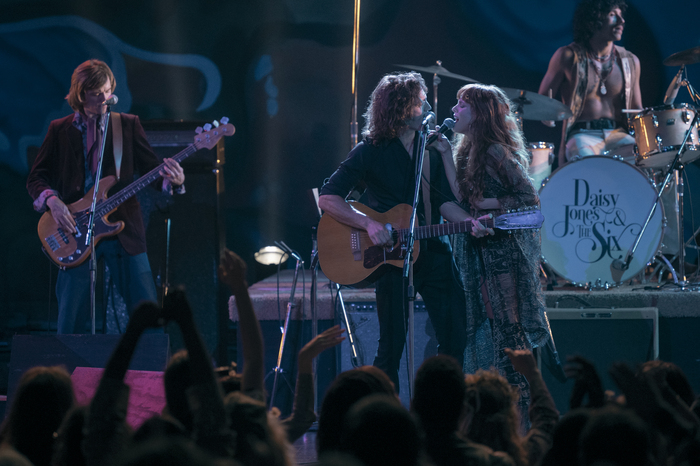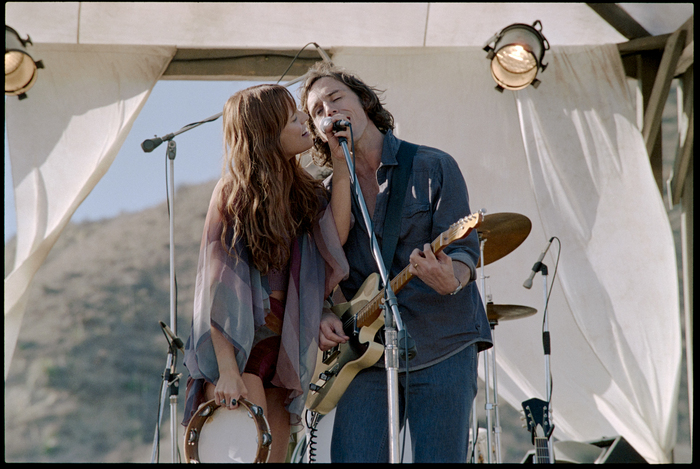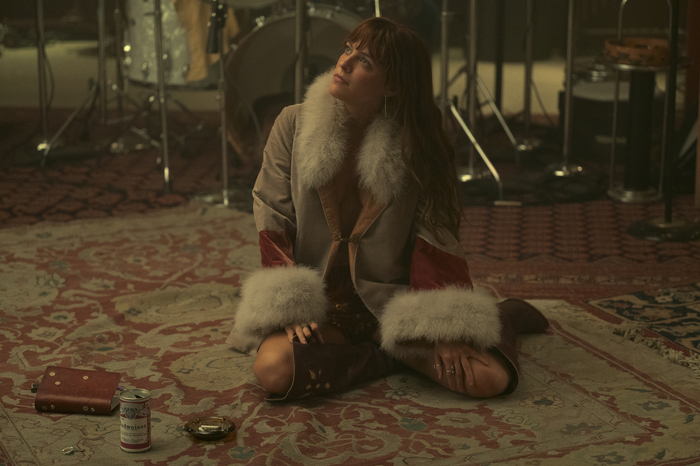Warning: Spoilers ahead for Daisy Jones and the Six
Sex, drugs and rock and roll abound in Daisy Jones and the Six, the rollicking, drama-filled show about a rock band from the ’70s, out March 3 on Amazon Prime. The 10-episode series, which stars rock progeny Riley Keough as the titular Daisy, was adapted for the screen from author Taylor Jenkins Reid‘s wildly popular novel of the same name. The book, which is written in the format of an oral history, centers on the fictional Daisy Jones and the Six, a rock band that rose to prominence in the ’70s, before abruptly and mysteriously dissolving, and features interviews with members of the band, their friends, families and colleagues. Through the interviews, readers discover the secrets—ranging from complex love triangles and bitter rivalries to secret desires and destructive addictions—that led to the band’s demise.
Showrunner and writer Scott Neustadter says the book provided an excellent foundation for creating the world of Daisy Jones and the Six—not only did the oral history format help shape the format of the series, but it also gave ample opportunity for creativity.
“I always knew that an oral history would lend itself well to a mockumentary or documentary sort of situation,” he tells TIME. “Early on, that helped make it a fairly seamless translation; later, we realized that a lot [of the book] is allusions to moments, things that she said or he said, but you might be missing the actual scene of what happened. So we got to invent those scenes from scratch—entire moments that we got to write from from beginning to end, which isn’t always the case with an adaptation. It afforded us so much fun and so many kinds of opportunities for drama will hopefully deepen the story.”
Here’s what to know about Daisy Jones and the Six and the book that inspired the series.

What are the biggest changes from the book to the screen?
Among the many changes made in the TV adaptation, the most prominent might be the complete omission of one of the members of The Six—puzzlingly making the band’s total number five, instead of six. In the book, The Six, a blues-rock band gets their name because of the number of members that they have: lead singer Billy Dunne and his guitarist brother Graham, drummer Warren, bassist Pete and his brother, Eddie, who becomes the lead guitarist after the band’s first one, Chuck, dies at war, and Karen, a keyboardist. In the series, Pete’s character is eliminated completely, with the band always having five members (although one leaves for college and is replaced by Karen). And in an early scene in the show, Karen suggests that the band be called The Six, implying that Billy’s girlfriend and later wife, Camila, who’s on tour with them, is the sixth member of the band. Showrunner and writer Scott Neustadter says the decision to write out Pete came from wanting to ensure that all the characters in the ensemble were fleshed out, with more minor characters in the book, like Teddy Price, a music producer, and Simone Jackson, a disco singer who is Daisy’s best friend, getting larger storylines in the series.
“When you adapt things for television, changes inevitably happen,” Neustadter tells TIME. “But this one didn’t stress us out too much. The Pete character serves a function in the novel, but he doesn’t have much to say, he’s not the most dramatic. We knew if we were going to cast Pete, the actor might want more to do. It felt like eliminating Pete enabled us to do more with the characters that we had in the ensemble, which was already a pretty big group of people. And I hope everyone, especially the Pete stans, forgive us after they watch the show.”
Read more: A Guide to All The Taylor Jenkins Reid Film and TV Adaptations

The expansion of Simone’s storyline marks another significant change. In the book, Simone is a successful disco singer who meets Daisy at a party in Los Angeles, beginning a life-long friendship that spans their respective musical careers. In the series, Simone’s meeting with Daisy is fairly similar, but her overall narrative is more complex. As an aspiring disco singer, Simone experiences challenges while trying to build her career because of sexual harassment and racial prejudice. She also falls in love with Bernice, a DJ in New York City’s queer underground club scene. For Neustadter, Simone’s broader storyline provided the opportunity to show a more diverse world outside of the insularity of Daisy Jones and the Six.
“We wanted to explore what it meant to be a queer Black woman in the world in that moment in time,” he says. “What would have to be compromised, what would have to be hidden? And especially in the world of disco, which is so much about freedom and expression, that dichotomy was was very interesting to us. We also really wanted to make sure that she was her own character, not someone whose only function was guiding Daisy’s story. That was really important to everybody.”
While adapting the book for the screen, another pivotal change was adjusting Camila’s storyline to really demonstrate her humanity. In the book, where the story is told entirely in the recollections of the band and their colleagues, Camila often comes off as saintly, a wife and mother often spoken of in reference to tolerating Billy’s indiscretions and struggles with addiction with patience and tenacity. In the series, however, Camila, who’s a photographer, struggles with her own vulnerabilities and challenges— she initiates Daisy joining the Six permanently, even though she seems to know it will bring her heartache and later, embarks on a one-time dalliance with Eddie after she suspects Billy and Daisy are having an affair.
“In the book, Camila just seems so pure and so good, but you have these little passages where she talks about meeting her friend for lunch and Billy says, ‘Oh, nobody has a lunch that’s as long as that one,’ and it just felt like on the periphery of the storytelling is a whole Camila life that we aren’t seeing in the book,” Neustadter says. “We all got very excited about telling the story of a version of Camilla that was really human, sometimes goofy, but someone who can understand that bringing Daisy into the band is both good for her and potentially not great for her, but making the decision to do it anyway.”
“For me, she was always the sort of most important character in the story,” he adds. “I think all these relationships were super messy, but there’s no good guy and there’s no bad guy. There’s just real people making decisions that they have to live with afterwards.”

Were Billy and Daisy romantically involved in the book?
The throughline of Reid’s book is the smoldering, yet underlying romantic tension between Billy and Daisy, who despite having undeniable chemistry, never act on their desires. In the series, however, the musicians’ chemistry and attraction to one another is far more overt—most cogently seen when the dynamic duo shares not just one, but two kisses. According to showrunner Will Graham, showing the romance on-screen was a way of contrasting reality with the ambiguity and fabrication present in the book’s different viewpoints, as well as the unreliability of memory.
“We realized early on that the book is telling you what Daisy and Billy and the rest of the band are willing to say, but there are moments when you really feel that things are sort of purposefully left ambiguous or people have different memories and different versions of of what happened,” Graham says. “And looking at it 20 years later, it’s a little messier and it’s a little more romantic.”

How did the creators adapt the book for the screen?
The process of adapting Daisy Jones and the Six for a television series started with an exhaustive foray into researching the history of music industry in the 1970s, paying special attention to the rock scene. Neustadter says that since both the book and series were formatted like an oral history of the band, they watched rock documentaries like Cameron Crowe’s David Crosby: Remember My Name, Andy Summers’ Can’t Stand Losing You: Surviving The Police, and Allison Ellwood’s History of the Eagles, as well as Jonathan Demme’s concert film of the Talking Heads, Stop Making Sense. The team also pored over books and articles about the rock scene and the artists that created it in the ’70s, as well as material about songwriting and the creative process. Graham says even the smallest of details added a level of veracity to the story; for example, in an episode when the band is finished with recording the album, Daisy decamps for Hydra, Greece—a location that they selected because it was famously a creative oasis for musicians like Leonard Cohen and Joni Mitchell.
Read more: Taylor Jenkins Reid Has Become a Bestseller Machine. She’s Wondering at What Cost
“We looked into every aspect of the period, we talked to a lot of people who were making music at the time, we talked to the producers, we talked to artists, we talked to people from labels,” he says. “It was just a beautiful experience, all in pursuit of really bringing a sense of authenticity to how the story was told and trying to make people really feel like they were in the studio or on the bus with them.”
Was Daisy Jones and the Six inspired by Fleetwood Mac?
With its heavy dose of sex, drugs and rock and roll, perhaps it should come as no surprise that Daisy Jones and the Six has drawn multiple comparisons to Fleetwood Mac, the iconic rock band whose interpersonal drama not only provided rich fodder for their music, but has become the stuff of rock legend. The comparisons are for a good reason—Reid was inspired by Fleetwood Mac and particularly, the passionate, but fraught and complex dynamic between Fleetwood Mac frontwoman Stevie Nicks and lead guitarist and singer Lindsey Buckingham, whose on-again, off-again relationship was memorialized in the band’s seminal album, Rumours. In an essay for Hello Sunshine, which produced the Daisy Jones and the Six Amazon adaptation, Reid pointed to a poignant moment where just Nicks and Buckingham are on stage performing the song “Landslide,” during a reunion concert that later became The Dance, a 1997 television special.
“When I decided I wanted to write a book about rock ‘n’ roll, I kept coming back to that moment when Lindsey watched Stevie sing ‘Landslide,'” Reid wrote. “How it looked so much like two people in love. And yet, we’ll never truly know what lived between them. I wanted to write a story about that, about how the lines between real life and performance can get blurred, about how singing about old wounds might keep them fresh.”
Neustadter says that while Fleetwood Mac was a major influence on the series, other classic rock artists like Tom Petty, Creedence Clearwater Revival, Joni Mitchell, and Bruce Springsteen also inspired the sound and feel of the show. “It’s a real amalgamation of this era and these artists. The end result shouldn’t feel like anyone doing a parody of anything, but like a real ’70s band that you just hadn’t heard that before.”

How Daisy Jones and the Six fits into the Taylor Jenkins Reid universe
Fans of Reid’s know that she often slips references to characters or events from other books into her work and Daisy Jones and the Six is no exception. In the book, the character Mick Riva, a Jagger-esque rock star and a major crossover figure in the Taylor Jenkins Reid universe (including 2017’s The Seven Husbands of Evelyn Hugo, where he is husband number three, and 2021’s Malibu Rising, a novel about Riva’s children), makes a cameo at a party that Daisy throws at the Chateau Marmont, where he orders alcohol for all of the guests and makes out with minors poolside. Daisy Jones is referenced in Reid’s 2018 novel, Evidence of the Affair, as a musical artist, as well Reid’s most recent book, 2022’s Carrie Soto Is Back, where the titular protagonist is reading a book about Daisy. Other characters from Daisy Jones and the Six also make appearances in Reid’s universe; The Six drummer Warren Rhodes, his wife, movie star Lisa Crowne, band The Breeze and The Six’s record label, Runner Records are all mentioned in Malibu Rising.
More Must-Reads from TIME
- Caitlin Clark Is TIME's 2024 Athlete of the Year
- Where Trump 2.0 Will Differ From 1.0
- Is Intermittent Fasting Good or Bad for You?
- The 100 Must-Read Books of 2024
- Column: If Optimism Feels Ridiculous Now, Try Hope
- The Future of Climate Action Is Trade Policy
- FX’s Say Nothing Is the Must-Watch Political Thriller of 2024
- Merle Bombardieri Is Helping People Make the Baby Decision
Write to Cady Lang at cady.lang@timemagazine.com